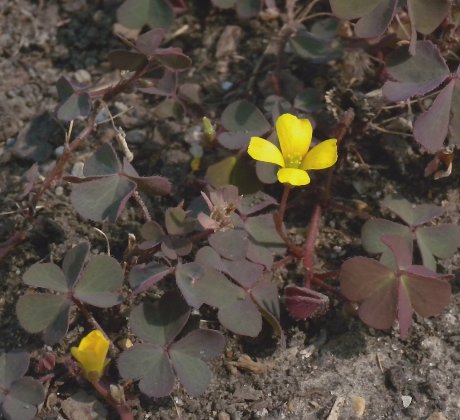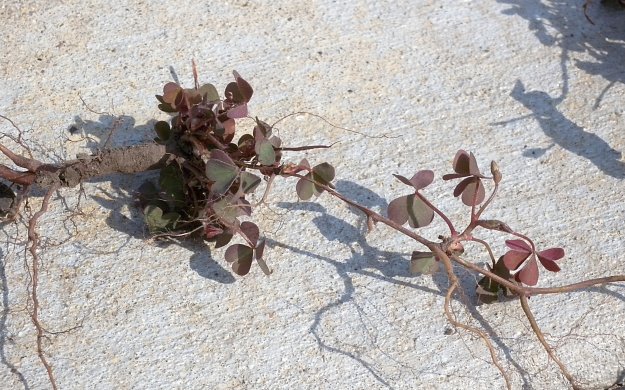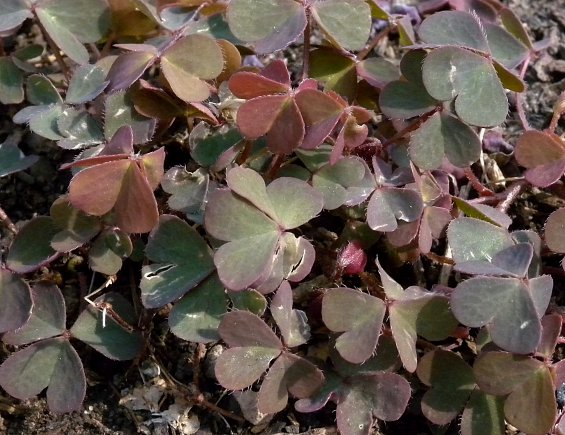
Flowers are produced either individually or in small umbels of 2-5 from the axils of the leaves and the tips of stems. Each flower is about ¼" across and a little longer in length, consisting of 5 light green to purple sepals, 5 yellow petals, 10 stamens, and a pistil with 5 styles that are fused together at the base. The sepals are lanceolate-oblong in shape and slightly pubescent; they are shorter than the petals. Sometimes the flowers are reddish toward the base of the petals. The pedicels of the flowers are about ¼-1" long, light green to reddish purple, terete, and appressed-pubescent, while the peduncle of an umbel of flowers is similar, except it is longer and more hairy. The blooming period occurs from early summer into the fall, lasting 2-4 months. Afterwards, the flowers are replaced by erect seed capsules about ½" long that are narrowly oblongoid-lanceoloid, 5-valved, and short-pubescent. The pedicels of the seed capsules are straight and either erect, ascending, or descending. Each capsule splits open into 5 parts, ejecting the seeds up to 10 feet. The seeds are 1.0-1.5 mm. in length, broadly ellipsoid in shape, somewhat flattened, and brown to reddish brown. Each lateral side of a seed has 7-9 transverse ridges. The root system consists of a fleshy taproot and stolons. This wildflower can reproduce vegetatively by forming rootlets along the nodes of its creeping stolons. Small colonies of plants are often produced.
Cultivation: The preference is full or partial sun, mesic conditions, and a fertile loose soil. This weedy wildflower can spread aggressively.

Range & Habitat: The non-native Creeping Wood Sorrel is occasional in widely scattered areas of Illinois (see Distribution Map). It is probably more common than these records indicate. It is not entirely clear where Creeping Wood Sorrel originated, but it was probably introduced into temperate North America from tropical America or tropical areas of the Old World. Habitats include lawns, gardens, mulched areas around shrubbery, plant nurseries, and greenhouses. Potted plants or shrubs from greenhouses or nurseries are often responsible for introducing Creeping Wood Sorrel into gardens and mulched areas. This wildflower prefers disturbed areas with little competition where the surface of the soil has been exposed.
Faunal Associations: The nectar and pollen of the flowers attract honeybees, little carpenter bees (Ceratina spp.), small leaf-cutting bees (Hoplitis spp., Osmia spp.), Halictid bees (Halictus spp., Lasioglossum spp.), Syrphid flies, small butterflies, and skippers (see Robertson, 1929). The caterpillars of an oligophagous moth, Galgula partita (The Wedgling), feed on Oxalis spp. Among vertebrate animals, the seeds are eaten by the Deer Mouse, White-Footed Mouse, and various birds, including the Bobwhite Quail, Mourning Dove, Slate-Colored Junco, Field Sparrow, Grasshopper Sparrow, Savannah Sparrow, and Tree Sparrow. The foliage of these plants is browsed by the Cottontail Rabbit and White-Tailed Deer. Because the foliage contains oxalic acid, it can be toxic to sheep and possibly other farm animals if it is eaten in quantity. A small amount of this foliage, however, is harmless.

Photographic Location: A shrubbery bed on the campus of the University of Illinois in Urbana, Illinois.
Comments: There are two color forms of Creeping Wood Sorrel. One color form has green foliage, while the other color form has purplish foliage, especially while growing in bright sunlight. In Illinois, the form with purplish foliage appears to be the more common of the two. Creeping Wood Sorrel is similar in appearance to two native species, Oxalis stricta (Yellow Wood Sorrel) and Oxalis fontana (Yellow Wood Sorrel). Neither of these two species produce creeping stolons, and they usually have a more erect habit of growth. Unlike the purple form of Creeping Wood Sorrel, the leaflets of Oxalis stricta and Oxalis fontana usually remain green in bright sunlight, although they sometimes develop a faint purplish tint. A scientific synonym of Creeping Wood Sorrel is Oxalis repens.